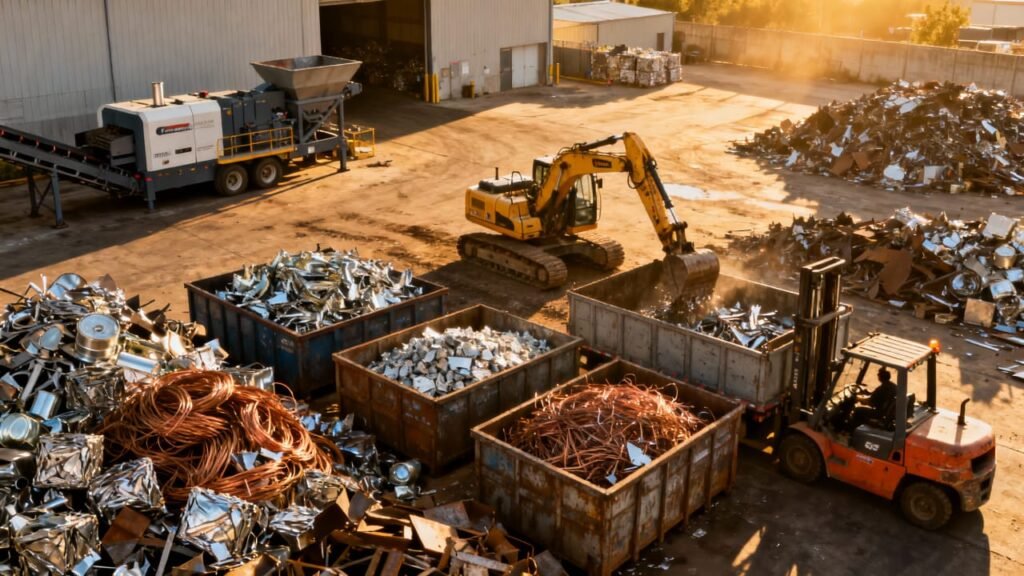Modern waste and recycling operations demand speed, adaptability, and cost control. Scrap yards and transfer stations handle thousands of tons of material each month — everything from metal and wood to mixed construction debris. Managing these waste streams efficiently can mean the difference between profit and backlog. That’s why more operators are investing in the Krokodile mobile shredder — a compact, powerful solution that transforms waste processing on-site and helps facilities handle higher volumes with lower costs.
1. The Challenge: Handling Diverse and Volatile Waste Streams
Scrap yards and transfer stations face constant challenges: limited space, fluctuating material types, and tight turnaround times. Every truck that arrives brings a new mix of metals, plastics, and construction debris. Processing all of this efficiently requires flexible equipment that can handle variability without constant adjustments.
Traditional stationary shredders, while powerful, lack mobility. They often require materials to be transported long distances across the yard or to external sites, wasting fuel and labor. In contrast, mobile shredders for scrap yards allow operators to bring the machine directly to the pile — not the other way around. This single change in workflow drastically reduces handling time and improves throughput across the entire facility.
2. Why Mobile Shredders Are a Game-Changer for Scrap Yards
For scrap yard managers, productivity is all about movement — how quickly materials flow from intake to resale or disposal. Mobile shredders streamline this process by reducing bulk, sorting faster, and minimizing downtime.
a. On-Site Material Reduction
Large, bulky waste slows down operations. A mobile shredder for scrap yards reduces size immediately upon arrival, cutting handling time and freeing up space for incoming loads. This means fewer forklift runs, shorter queues, and faster inventory rotation.
b. Efficient Metal Recycling
In facilities dealing with ferrous and non-ferrous metals, pre-shredding is crucial. On-site metal recycling with a mobile shredder enables operators to prepare materials for baling or smelting without sending them to external processors. The result: higher margins and reduced transport costs.
c. Increased Throughput
Every minute counts in high-volume environments. The Krokodile mobile shredder can process a wide range of materials continuously, keeping conveyors and sorting lines fed without interruptions.
d. Better Quality Control
Shredded materials are more consistent and easier to separate, improving downstream recovery rates. This helps scrap yards maintain quality standards for resale and meet strict recycling requirements.
3. How Transfer Stations Gain Efficiency With Mobile Shredders
Transfer stations serve as the middle link between collection routes and final processing sites. Their success depends on rapid turnaround and optimal load management. By integrating mobile shredders into daily operations, these facilities can significantly reduce costs and boost efficiency.
a. Space Optimization
Transfer stations often operate within limited footprints. Bulky, unprocessed waste takes up valuable room, forcing more frequent hauls. With transfer station waste processing done on-site via mobile shredding, operators can compact and sort waste more effectively, maximizing every square meter of available space.
b. Reduced Transportation Costs
Hauling partially filled trucks is one of the biggest inefficiencies in waste management. Pre-shredded material is denser, allowing for more tons per load and fewer trips to landfills or recycling plants. This translates directly to fuel savings and lower fleet wear.
c. Streamlined Sorting Operations
Once materials are shredded, sorting becomes faster and more accurate. Whether the goal is on-site metal recycling, separating plastics, or removing contaminants, smaller particle sizes improve both manual and automated sorting systems.
d. Environmental Compliance
Transfer stations are often under strict scrutiny for noise, dust, and emissions. The Krokodile mobile shredder operates quietly and efficiently, with advanced emission controls that meet environmental standards in most regions.
4. The Advantages of Compact Shredders for Waste Management
Both scrap yards and transfer stations benefit from equipment that can do more with less space. That’s where compact shredders for waste management stand out — offering industrial-grade performance in a mobile, easy-to-maneuver package.
a. Mobility
Unlike stationary units, compact mobile shredders can move between piles, zones, or even locations. For example, a transfer station might use one unit in the morning for municipal solid waste and relocate it later for green waste or metal recycling.
b. Versatility
The Krokodile mobile shredder can process wood, concrete, asphalt, plastics, tires, and mixed demolition waste. Its twin-shaft system adapts to variable material density without frequent adjustments or risk of jams.
c. Low Maintenance
Compact shredders are designed for continuous operation with minimal servicing. Hydraulic drive systems and self-cleaning shafts reduce wear, keeping machines productive even in dusty or wet environments.
d. Cost Efficiency
Smaller footprint means less energy consumption and easier transport. Facilities can achieve industrial throughput without the overhead of large fixed installations.
5. Real-World Scenarios: Mobile Shredding in Action
a. Regional Scrap Yard Network
A multi-site scrap metal company uses one mobile shredder for scrap yards across several locations. Instead of maintaining multiple fixed shredders, they transport a single Krokodile unit on a flatbed truck. The result: lower capital expenditure and consistent shredding performance at every facility.
b. Municipal Transfer Station
A mid-size city deployed a Krokodile mobile shredder to process mixed waste from residential collection routes. By shredding on-site before compaction, the city reduced hauling trips by 35%, saving thousands in fuel and labor.
c. Construction Waste Transfer Facility
A private waste contractor integrated on-site metal recycling with a mobile shredder. The system now processes metal, concrete, and wood in a single shift, preparing clean streams for resale and recycling — without outsourcing.
6. Sustainability and Environmental Impact
Efficient waste processing isn’t just about economics — it’s also about sustainability. Mobile shredders for scrap yards and transfer stations reduce greenhouse gas emissions by cutting the number of truck trips required for waste transport.
By promoting transfer station waste processing on-site, facilities can divert a larger portion of waste from landfills and contribute to circular economy goals. Recycled metals, plastics, and aggregates become valuable commodities rather than environmental burdens.
The Krokodile mobile shredder is designed with these values in mind. Its fuel-efficient engine, reduced noise output, and optimized shredding system align with modern environmental standards and community expectations.
7. How to Integrate Mobile Shredders Into Your Operation
Adding a mobile shredder to your scrap yard or transfer station doesn’t require a major overhaul. Here’s a step-by-step approach:
- Assess Your Waste Streams
Identify the materials that cause the most handling challenges — bulky waste, mixed debris, or metal scrap. - Select the Right Shredder Model
Choose a machine with the throughput and mobility that match your daily volume. The Krokodile mobile shredder offers flexible configurations for varied workloads. - Train Operators
Basic training enables your crew to operate the machine safely and efficiently within a single workday. - Plan for Mobility
Determine the best routes for moving the shredder between piles or zones. Flexibility is key to maximizing efficiency. - Track Results
Measure performance by monitoring reduced hauling trips, increased recycling rates, and improved load density.
8. The Bottom Line: Power, Flexibility, and Profitability
In industries where margins are tight and time is money, mobile shredders for scrap yards and transfer stations are redefining efficiency. These machines combine industrial power with on-site flexibility, allowing operators to process waste faster, cleaner, and more profitably than ever before.
The Krokodile mobile shredder isn’t just a piece of equipment — it’s a productivity tool. From on-site metal recycling to optimized transfer station waste processing, this compact machine helps modern waste facilities reduce costs, improve sustainability, and stay ahead of the competition.
For any operation looking to do more with less, it’s time to rethink waste management — one mobile shredder at a time.



